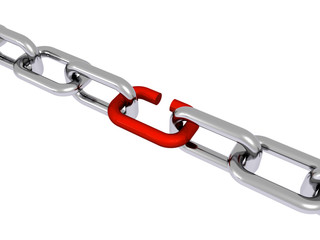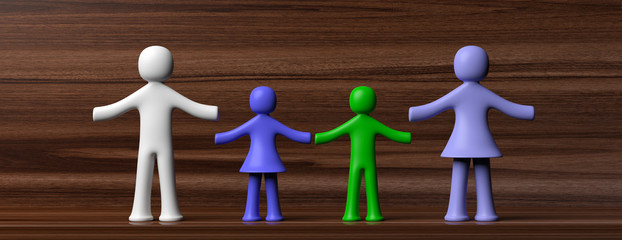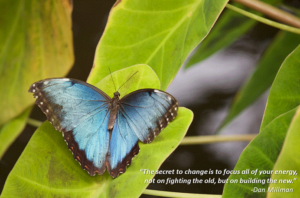Growth comes through Change
I have often marveled at the metamorphosis that is represented by the butterfly. The drastic change from egg, to larva to chrysalis to butterfly is fascinating. Most of us think simply of the change from caterpillar (sludging on leaves and eating all in sight) to butterfly (flying gracefully, beautifully and lilting among the flowers). Like all lifeforms it is a cycle. The egg (the size of a pinpoint for the Monarch butterfly) opens into a larva (what we think of as the caterpillar and initially not much bigger than the egg). During this larva stage the Monarch will grow from a pinhead to about two inches. The phase that is different from most species is the chrysalis or cocoon stage, kind of like adolescence for humans except as humans we work hard to help teenagers through life changes rather than put them in an enclosed container walled off from society. From the cocoon (with much apparent strain and struggle) the butterfly emerges. The butterfly’s job is to seek out the best place to lay eggs. Repeat the process.
Change happens much the same way for humans except that for many of the changes that humans face the process includes an element of choice. The best-known theory of change is the Transtheoretical Model developed by James Prochaska and others. This model plays out the states as precontemplation (no thoughts of change), contemplation (maybe change should happen), preparation (how should this change happen), action (make the change), and maintenance (keep the change happening) and termination (the problem that the change was needed for no longer exists). Another critical element of the model is relapse (reverting to previous behavior) which can happen at any stage of the model. As an example of how the theory works could be making yoga a consistent practice.
Precontemplation may not seem like a stage of change because it is a precursor to change that occurs before an aha moment that signals that change can be an improvement. In the precontemplation stage we are unaware that change even needs to happen. At this stage we may know that yoga exists, but we have had no thoughts of adding it to our routine.
The aha moment is when precontemplation moves into the contemplation stage. The contemplation stage indicates awareness that change would be a good thing. This stage also begins the gathering of information. At this stage we begin researching how yoga can be helpful, whether we want to seek out a class or do it at home.
Moving from the contemplation stage to the preparation stage occurs as more thought is given to the decision and a stronger commitment is made to follow through. An additional element of preparation may be gathering tools needed for action. At this stage we may procure appropriate attire and accessories for yoga, maybe buying a yoga mat and flexible clothing.
The preparation stage moves into the action stage when, well, actions are taken. The action stage is when the practice of yoga at home or in a class takes place.
The maintenance stage is the process of making a change a habit. For this illustration the maintenance stage would indicate a consistent practice of yoga.
The final stage of TTM is the termination stage. This is not a termination of the new habit, but rather a termination of the concern that the new habit addressed. At this stage the act of not doing yoga would be distressful, creating a feeling of loss.
It is easy to see how relapse can occur at any of the stages. A new healthy habit may be considered (contemplation stage) and then the thoughts wander away. Or perhaps the new habit was not only considered but also tools were obtained (preparation stage) and yet no action was taken. Maybe action was taken a few times and could not be maintained. Relapse is not failure, rather it is an invitation to revise and redo.
Dealing with Seasonal Depression
For many folks as the days get shorter, depression sneaks up on them. It is called seasonal depression or seasonal affective disorder (SAD). Sounds like an appropriate acronym. It can happen at other times of the year, but most often it starts in fall or winter and lasts until spring or early summer.
People with SAD have signs of depression like many other people such as:
- Less energy
- Trouble concentrating
- Fatigue
- Increased appetite
- Need for more sleep
- Weight gain
Some simple steps can be taken to avoid using medication to treat SAD. Working with a counselor who can assist you with increasing your understanding of your symptoms is a good start. Additionally, seeking ways to increase exposure to natural light. Spending a bit of time outside in the morning can help boost the lowered levels of serotonin.
Date Night
When we are single, we date others to find a potential partner. Then when we find the one we are going to call partner, we don’t need to date anymore, right? Wrong!! A healthy relationship depends on healthy communication and quality time spent together. It is a common phenomenon that couples get married and have children and when the children grow up and “leave the nest”, the couple that started all of this look across the table at each other and wonder who they are looking at. Raising kids is a big job. But so is a healthy relationship. Making time for the one that you love makes them feel heard, understood, and loved. It also reminds them that they are important to you. So Date Night is more critical with your partner than with your potential partner.
Just what is Date Night? The critical part of Date Night is the communication. It is sharing thoughts, feelings and ideas with each other that the typical hectic life we lead does not always allow us to do. Date Night can include a movie, a play, a concert, or anything else we need to sit quietly through, so long as it also includes discussion time before or after. Date Night also has no real budget. It can be a special occasion for which we pull out all the stops or it can be a picnic in the garage. Once again it is about the quality time spent together and the communication that occurs.
It’s important to note that for parents, conversation about the kids is strictly off limits. Conversation about the kids is for Parents Night, not Date Night.
It is also important that both parties have plenty of time to speak. Nobody enjoys a date when one person does all of the talking. If you need help getting your Date Night routine started, come see me.
What are your thoughts about Date Night?
Rosemary Behrens, Ph.D. Family Counselor
Weakest Link
As the saying goes, a chain is only as strong as its weakest link.

It is also true that a family is only as strong as its weakest dyad. A dyad is a relationship between two people. So a family of four has six dyads. Mom to and from Dad (1), Dad to and from each kid (2), Mom to and from each kid (2) and of course older kid to and from younger kid (2). So you can see the more members of the family the larger the number of dyads.

When all of the dyads are healthy, the family is highly likely to be healthy overall. When even one link is not healthy it can serve to weaken the whole family. Think about it, can you recall a family where two siblings did not get along and it colored the dynamics in the rest of the family? Some members of the family changing their behavior to appease one or both of the two that are not getting along. Or families that look like the one in the picture about and each parent has a favorite child?
Family counseling can help identify the weak dyads, the possible reasons the dyads are weak, and assist the entire family in making the family system (the chain) strong again. Keeping balance in the family is not easy. We can work with you to help strengthen the dyads that will make your family strong.
Rosemary Behrens, Ph.D. Family Counselor
Crazy Love: The Signs of Domestic Abuse
Sometimes stress on the family can change from discord to abuse.
Domestic abuse comes in many varieties and is not restricted to socioeconomic level, age or culture. Nor is it restricted to physical abuse. Before we can assist victims of domestic abuse we must first gain an understanding of the ways that abuse happens, many of which do not leave visible scars. When we can gain a better understanding of the different types of abuse, the cyclical nature of abuse and productive ways to assist the abused, we can better identify when loved ones are in the midst of abusive situations and help them emerge on the other side. What the abuse victim needs most is love and care and an outlet to share their struggles. What they do not need is a savior to swoop in and save the day. Abuse comes in many forms besides physical abuse. Verbal abuse, emotional abuse, social abuse, cultural abuse, sexual abuse, using the kids for abuse are but a few of the ways that abuse can happen without leaving visible scars to prove the abuse.
Survivors of Childhood Sexual Abuse Workshop
Workshop Date: May 19, 10:00 AM – 12:00 PM Location: 9219 Katy FWY., Suite 165 Houston, TX. 77024
“Sexual abuse can be hard to define because of the many different forms it can take on, the different levels of frequency, the variation of circumstances it can occur within, and the different relationships that it may be associated with.” Hall and Hall
There are varied reactions to childhood sexual abuse. These reactions are highly dependent on the age the abuse started, the frequency of abuse, the time of the outcry, the reaction of the nonoffending parent, and the nature of the relationship with the abuser. Inner Peace Counselors is presenting a workshop for Survivors of Childhood Sexual Abuse in May.
The topics to be covered are as follows:
- Transforming anger into a sense of release
- Rebuilding self-esteem
- Understanding how other parts of life have been affected and
- Moving from surviving to thriving
Anger: Anger is a common (and appropriate) reaction of survivors of childhood sexual abuse. Anger often impacts the one who is angry more than the target of that anger. Anger can also be internalized and increase stress, anxiety and depression. Letting go of the anger is not synonymous with forgiving the abuser. Learning how to release the anger and move in a more positive direction is a step toward healing. It is also a step toward releasing the power that the abuser continues to hold on the survivor.
Low self Esteem: Another common concern for survivors of childhood sexual abuse is low self-esteem. This is a common phenomenon because verbal and emotional abuse usually accompany childhood sexual abuse. Low self-esteem can leave survivors vulnerable to future forms of abuse and can lead to unhealthy adult relationships. Rebuilding self-esteem can be accomplished by focusing more on positive accomplishments that have happened and focusing less on the negative voices that berate us. Sometimes it is necessary to change the people around you. Much like an airplane, self-esteem builds much faster for survivors who surround themselves with people who lift their spirits rather than people who drag their spirits.
Low Trust: It is important to gain an understanding of how childhood sexual can have long lasting impacts on many aspects of our lives. Being abused by someone in your family who you are supposed to be able to trust will invariably lead to trust issues for the adult who has survived childhood sexual abuse. Being exposed to sexual activity before a child has reached an appropriate level of social development for sexual development to begin can distort adult sexual behavior. It is common for survivors to either be afraid of having sex with anyone or feel that they must have sex with everyone. It is also common for survivors to dissociate during sexual activity.
Anxiety: Survivors of childhood sexual abuse are likely to experienced heightened anxiety. Anxiety is our body’s way of responding to perceived threats. This response is noted as the fight or flight response. Another response option is to freeze. Heightened anxiety lays the groundwork to perceive threats in situations that are non-threatening. It can also lead to paranoia and even panic attacks. Survivors sometimes respond to the loss of control experienced in the abuse by exerting control over an area of their life that they have control, their weight. This control may take the form of anorexia or bulimia or significant weight gain in the hopes of becoming unattractive to the abuser.
Thriving: Moving from surviving to thriving is accomplished when the survivor recognizes the ways that that their anger, self-esteem and other areas of their life have been distorted by the abuse they have survived. Thriving does not mean that the abuse is forgotten or forgiven, it means that it has lost its power.
Quotes:
The knot in the bark reminds the tree of trauma survived. The knot may soften but it remains to remind the tree that it has indeed survived. –Rosemary Behrens
Childhood sexual abuse leaves scars that may fade but never completely go away, however, you can reduce, dissipate or transform the pain into release and wisdom. — Rosemary Behrens.
“I tell you, Chickadee
I am afraid of people
who cannot cry
Tears left unshed
turn to poison
in the ducts.” Alice Walker
Rosemary D. Behrens, PhD, LPC-S
9219 Katy FWY.
Suite 165
Houston, TX. 77024
Office: 832-470-7890





